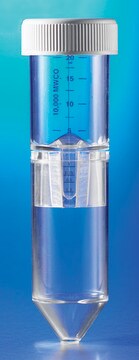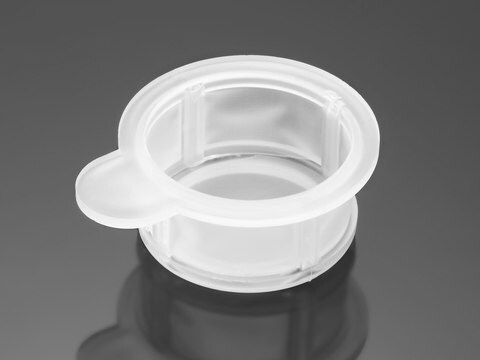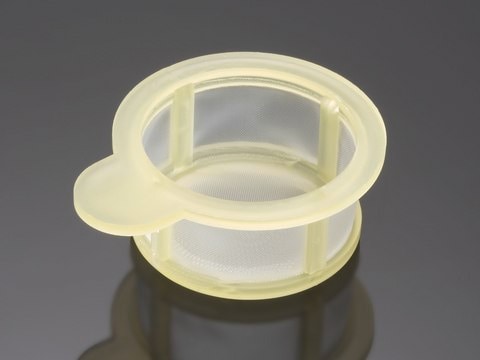CLS431752
Corning® cell strainer
pore size 100 μm, yellow, sterile, pkg of (individually wrapped), pack of 50 ea
Synonym(s):
Cell strainer
Sign Into View Organizational & Contract Pricing
All Photos(1)
About This Item
UNSPSC Code:
41104932
NACRES:
NB.24
Recommended Products
material
Nylon
yellow
sterility
sterile
packaging
pack of 50 ea
pkg of (individually wrapped)
manufacturer/tradename
Corning 431752
pore size
100 μm
Looking for similar products? Visit Product Comparison Guide
General description
Corning® 100µm Cell Strainer is a sterile, easy-to-use device for rapidly isolating primary cells to consistently obtain a uniform single-cell suspension from tissues. Applications include stem cells and primary cells. Individually packaged, 50/case.
Application
- Faster, easier alternative to gauze filtration
- Ideal for preparation of flow cytometry samples, including:
Single cell suspensions of blood cells from marrow, pancreas, thymus, tonsil, and lymph nodes
Stem cells, tissue-derived cells, and cancer cells
Preparation of specimens for primary cell cultures and immunogens
Preparation of freezing stocks
Filtering agglutinative proteins produced in inactivation serum
Features and Benefits
- Strong nylon mesh with 100- micron pores for optimal performance in a variety of applications
- Evenly spaced mesh pores providing consistent and reliable results
- Conveniently accessible in individual packaging
- Extended lip on strainer enables aseptic handling with forceps
- Molded color-coded polypropylene frame with tab enables easy handling and identification
- Fits all major brands of 50mL Conical Tube
- Disposable, easy-to-use, inexpensive, maintains sample integrity
- Sterilized by gamma irradiation, noncytotoxic
Legal Information
Corning is a registered trademark of Corning, Inc.
Certificates of Analysis (COA)
Search for Certificates of Analysis (COA) by entering the products Lot/Batch Number. Lot and Batch Numbers can be found on a product’s label following the words ‘Lot’ or ‘Batch’.
Already Own This Product?
Find documentation for the products that you have recently purchased in the Document Library.
Customers Also Viewed
Arjun Challagulla et al.
Microorganisms, 9(1) (2021-01-17)
Marek's disease (MD), caused by MD herpesvirus (MDV), is an economically important disease in chickens. The efficacy of the existing vaccines against evolving virulent stains may become limited and necessitates the development of novel antiviral strategies to protect poultry from
Emma Lång et al.
Nature communications, 9(1), 3665-3665 (2018-09-12)
Epithelial sheet spreading is a fundamental cellular process that must be coordinated with cell division and differentiation to restore tissue integrity. Here we use consecutive serum deprivation and re-stimulation to reconstruct biphasic collective migration and proliferation in cultured sheets of
Zhi Chen et al.
American journal of translational research, 12(6), 2379-2395 (2020-07-14)
Inflammation is a leading cause of severe acute pancreatitis (SAP). MicroRNAs (miRNAs) are emerging as important regulators involved in the pathogenesis of many diseases including pancreatitis. To identify miRNAs that contribute to the pathology of SAP, we carried out a
Joanna Kalucka et al.
Cell, 180(4), 764-779 (2020-02-16)
The heterogeneity of endothelial cells (ECs) across tissues remains incompletely inventoried. We constructed an atlas of >32,000 single-EC transcriptomes from 11 mouse tissues and identified 78 EC subclusters, including Aqp7+ intestinal capillaries and angiogenic ECs in healthy tissues. ECs from
Christinna V Jørgensen et al.
Journal of pharmacological and toxicological methods, 97, 59-66 (2019-04-05)
Adipose tissues release adipokines, which regulate energy intake and expenditure. G protein-coupled receptors (GPCRs) and associated signaling pathways in adipocytes are potentially important drug targets for conditions with disturbed energy metabolism. The aim of the current study was to compare
Articles
Organoid culture products to generate tissue and stem cell derived 3D brain, intestinal, gut, lung and cancer tumor organoid models.
Our team of scientists has experience in all areas of research including Life Science, Material Science, Chemical Synthesis, Chromatography, Analytical and many others.
Contact Technical Service










